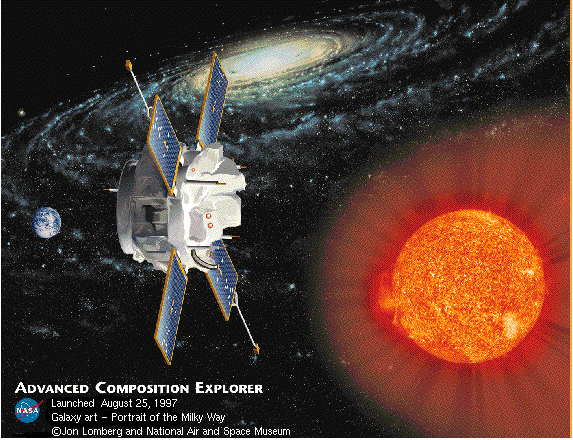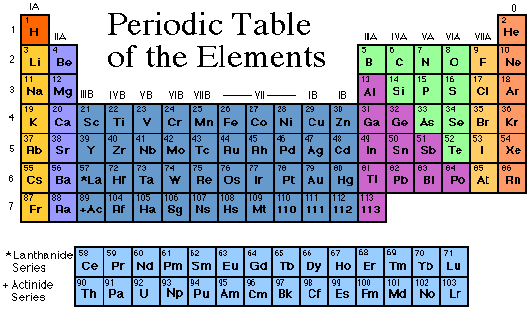OVERVIEW OF ACE SPACECRAFT:
- The matter which makes up the hair on our heads to the toes on our feet is made of the same particles as the Earth, the Sun, the Milky Way galaxy, and the galaxies beyond. These particles all had their origin in the Big Bang (the lighter elements) or distant stars (the heavier elements). The process which occurs in the stars to produce new atoms, ions, and isotopes is nuclear fusion. Supernova explosions produce the elements that are heavier than iron. This process produces many products including electromagnetic radiation and a variety of different particle types. It is the purpose of the ACE (Advanced Composition Explorer) spacecraft to sample the matter that
comes near the Earth from the Sun, the space between the planets, and the Milky Way galaxy beyond the solar system.
- ACE was launched in August of 1997. The ACE spacecraft contains nine instruments which have varying capabilities to measure particle types, charge, mass, energy, direction of travel, and time of arrival to the spacecraft. The nine instruments work simultaneously to create a comprehensive view of the particles which stream past ACE. Data from ACE is contributing to our understanding of the origin and evolution of the solar system and the processes involved. During its first year, ACE
has already collected more data on many isotopes in ACE's energy range than all previous instruments combined.
ACE is unique in that it samples lower energy particles of solar origin and higher energy galactic particles with a collecting power 10 to 1000 times greater than past experiments measuring similar particles in comparable energy ranges. ACE is orbiting the Earth-Sun libration point, L1. This is a point in space where the Earth's gravitational attraction and the Sun's gravitational attraction along with centripetal force are in equilibrium. At this point the orbit is easily maintained by the
balance of these forces. This point is approximately 1/100 of the distance from the Earth to the Sun.
ATOMIC STRUCTURE, NUCLEAR PHYSICS AND ACE:
- Our understanding of the building blocks of matter has evolved continuously throughout the twentieth century. By the 1930s it became generally accepted that the basic building blocks of the universe were protons, neutrons, and electrons, rather than atoms. Each element's characteristic physical and chemical properties are determined by the number and arrangement of these three elementary particles. The positive charge of an atom, as well as almost all its mass, is concentrated
at the center of the atom in its nucleus. The nucleus is a tightly bound cluster of protons and neutrons. There is one important difference between neutrons and protons. Every proton carries a definite positive electric charge, whereas neutrons are neutral. While most of the atom is empty space, each atom contains a definite number of electrons which orbit in that space. Electrons have very little mass (approximately two thousand times less than a proton), but each electron has a negative charge equal in magnitude to the positive charge
on a proton. The identity of an element is determined by the number of protons in the nucleus of the atom. For example, hydrogen atoms have one proton, helium atoms have two protons, and so on. The number of neutrons determines what specific isotope of an element is present. For example hydrogen atoms can have zero, one, or two neutrons. Since the 1930s hundreds of other sub-atomic particles have also been discovered.
When the number of protons in an atom equals the number of electrons, the substance is neutral and will exist as one of the |
three basic states of matter: a solid, liquid, or gas. At very high temperatures or when bombarded by high energy particles or radiation (UV, X rays, or gamma rays), neutral atoms can lose one or more electrons. The resulting positively charged particles are called ions. Ions and free electrons can exist as a plasma, the fourth state of matter.
- The instruments on the ACE spacecraft study electrons and a variety of isotopes. In general, the particles that ACE investigates have a high amount of kinetic energy (they are moving very fast), and these high energy particles are ionized.
- CHARACTERISTICS OF THE PARTICLES MEASURED BY ACE:
- The characteristics of the particles measured by the ACE spacecraft include:
- • particle type - The particle types measured include protons, electrons, and the isotopes of the elements from hydrogen through zinc, which includes the three categories of cosmic rays. Cosmic rays are the particles and high energy light (photons) that bombard the Earth from any location outside the atmosphere. Scientists classify cosmic ray particles depending on their source. The three categories are :
- •SEPs (solar energetic particles), which are lower energy cosmic rays of solar origin,
•ACRs (anomalous cosmic rays), which originate within local interstellar space,
•GCRs (galactic cosmic rays), which originate far outside the solar system but mainly within the Milky Way galaxy.
- •charge - The particles ACE can measure may be positive or negative.
•mass - The ACE/ULEIS and SWIMS instruments use "time-of-flight” to determine the mass of particles by measuring their travel time through a chamber, while SWICS uses “post-acceleration” wherethe particle is stopped and then reaccelerated to determine itsmass. SIS and CRIS measure mass as well.
•direction of travel - Most of the ACE instruments measure the incoming direction of the particles.
•time of arrival to the spacecraft - The arrival time for each particle is recorded and monitored.
•energy - The SI unit for energy is the joule. Since the joule is a very large unit for dealing with electrons, atoms, or molecules, the unit used by scientists to measure the energy of these particles is the electron volt (eV). An eV is defined as the energy acquired by an electron as a result of moving through a potential difference of 1 volt. Since the charge on one electron is 1.6 x 10-19 coulombs (the SI unit for charge), and the change in potential energy is equal to charge times voltage, then 1 eV is equal to 1.6 x 10-19 joules. Typical molecules in our Earth's atmosphere have
energies of around 0.03 eV. Protons in the Earth’s magnetosphere and the Sun’s plasma are more energetic and would typically have energies from 1000 eV (which is typical of a dental X-ray) to 10,000 eV (which is equivalent to radioactive decay particles). GCRs measured by CRIS get up to 5 x 108 eV and the highest energy cosmic rays (not measured by ACE) can have energy greater than 1020 eV.
|

